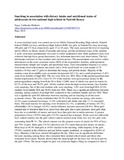| dc.description.abstract | A cross-sectional study was carried out in two Public National Boarding High schools, Nairobi School (NBlS) for boys and Kenya High School (KHS) for girls, in Nairobi Province involving 180 girls and 172 boys respectively aged 13 to 18 years. The study assessed the level of snacking and its effects on dietary intake of proteins and energy and the nutritional status of the students.
A semi- structured questionnaire was used to collect quantitative data while qualitative data were collected through focus group discussions, key informant interviews and observations. The key informants consisted of class teachers and caterer/cateress. The questionnaire was used to collect information on the socio-economic status (SES) of the respondents' families, anthropometric measurements (height and weight) and nutritional status, food consumption frequency to assess food intake from school meals and snacks and a 24-hr recall based on a sub-sample of 31 students (14 boys and 17 girls) to determine the energy and protein intake.
Majority of the students came from middle socio-economic background (65.1 %), and a small proportion (3.4%) came from families of high SES. The rest were from low SES. Most of the parents/guardians had formal employment (63.2%). Up to 91.1% of the students were given pocket money by the parents/guardians ranging from Kshs 50 to Kshs 12,000, most of which was spent on snacks by 62.7% of the boys and 74.5% girls. All the students from the high socioeconomic class families were snacking.
Out of the total students who were snacking, 3.8% were from high SES, 67.6% students from middle SES and 28.6% from low SES. There was a significant difference between snacking among students from high SES compared to the combined middle and low SES. There was a significant (p<0.05) difference between snacking and no snacking in all the socio-economic classes.
The study established that 58.3% of the students ate energy-rich snacks, 22.2% sugar-sweetened beverages, 11.4% carbonated soft drinks and only 1.1 % consumed fruits. The main reasons for snacking were boredom (52.1%), availability of money (45.7%), affordability (36.3), hunger (34.4%), media influence and peer-pressure (28.4%). More girls snacked due to boredom than boys, more boys than girls due to peer pressure, more girls than boys due to availability of money and more boys than girls due to media pressure.
A greater proportion of boys (18.9%) than girls (15.5%) snacked due to hunger. Fruits were not sold in the boys' school canteen, but the girls' school canteen stocked some fruits, but very few girls were consuming them ᆱ1 %). The school canteen was the greatest source of snacks for 95% of boys and 79% of girls. More girls (74.5%) than boys (62.7%) spent their pocket money on snacks. More boys at 49.4% than girls at 10.9% snacked in the morning, while majority of the girls (75.8%) snacked in the afternoon and just before supper combined, as compared to 42.6% of boys. Majority of the boys snacked throughout the day. There was no significant difference between snacking among those who consumed three normal school meals and those who consumed fewer meals.
Results showed that the mean height for the boys was 162.8cm and for the girls 159cm. The mean weight for girls was relatively higher (56kg) as compared to that of boys (51.7kg). However results show that significantly a higher percentage of girls achieved RDAfor energy (42.0%) than boys. This trend was the same with carbohydrates (4l.9%), and fat (35.5%). But the trend was reversed in protein intake with boys consuming more protein (32.2%) than the girls.
Results also indicate that significantly a higher percentage of boys did not achieve RDA for energy (28.6%) than girls (23.5%). This trend was the same with fats. However, significantly a higher percentage of girls than boys had inadequate RDA achievement for carbohydrate and protein. There was no significant difference between the nutrient adequacy of those who were snacking and those who were not. Although snacking may have reduced consumption of food from regular school meals, it did not affect the RDAs of protein and energy for the students.
The study showed that 89.3% of the students had normal height-for-age and 75.6% normal BMIfor-age. The proportion of girls with normal nutritional status was 38.1 % and 37.5% for boys. Underweight among boys at 19.9% was significantly higher than among girls at 2.4%. Girls were significantly more obese at 5.9% than boys at l.2%. The girls generally had a better nutritional status than boys. Those underweight were mainly from the low socio-economic class families for both boys and girls. More girls were overweight at 16.4% than boys at 2.9%. Girls were more likely to be overweight and obese than boys. Those overweight or obese were mainly from the high SES, some of who were getting over KSH 5,000.
The boys' normal BMI-for-age was not significantly different from that of girls. Normal height-for Age did not differ between boys and girls. There was no significant relationship between snacking and BMI- for-Age and hence Nutritional status of the high school adolescents. The study concluded that snacking was rampant in both schools but more with girls than boys. Significantly more girls were overweight and obese than boys. Stunting was not significantly different between the two groups. Underweight was significantly higher in boys than in girls. Therefore, snacking did not have a significant (p>0.05) effect on nutritional status. | en_US |

